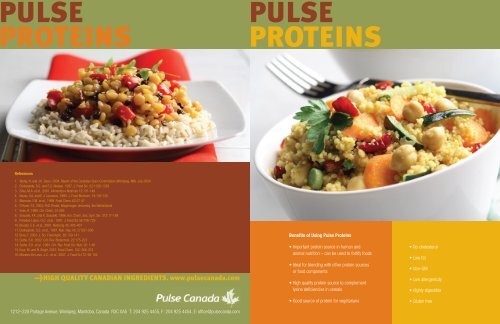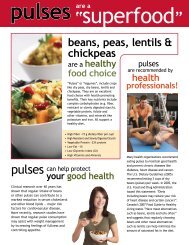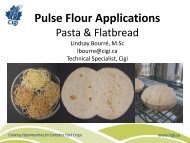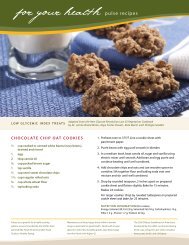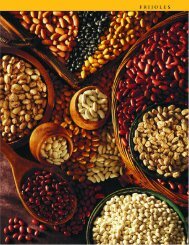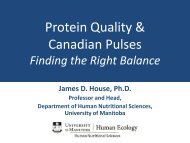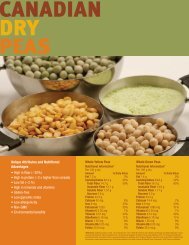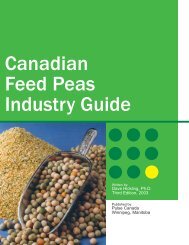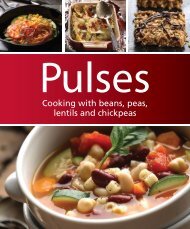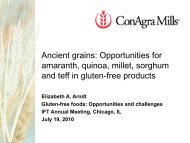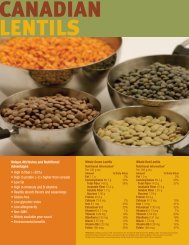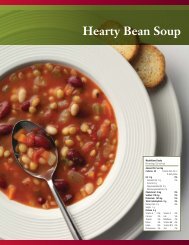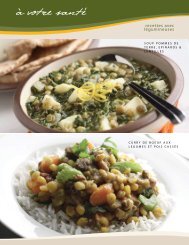Pulse Proteins - Pulse Canada
Pulse Proteins - Pulse Canada
Pulse Proteins - Pulse Canada
You also want an ePaper? Increase the reach of your titles
YUMPU automatically turns print PDFs into web optimized ePapers that Google loves.
PULSEPROTEINSPULSEPROTEINSReferences1. Wang, N. and J.K. Daun. 2004. Report of the Canadian Grain Commission (Winnipeg, MB). July 20042. Deshpande, S.S. and S.S. Nielsen. 1987. J. Food Sci. 52:1326-13293. Silva, M.A. et al., 2001. Alimentos e Nutricao 12:131-1494. Neves, V.A. and E.J. Lourenco. 1995. J. Food Biochem. 19:109-1205. Marcone, F.M. et al., 1999. Food Chem. 62:27-476. O’Kane, F.E. 2004. PhD.Thesis, Wageningen Universtiy, the Netherlands7. Vose, R. 1980. Cer. Chem. 57:4068. Sosulski, F.K. and K. Sosulski. 1986. Am. Chem. Soc. Sym. Ser. 312:17-1899. Paredes-Lopez, O.C. et al., 1991. J. Food Sci 56:726-72910. Bruado. E.E. et al., 2001. Nahrung 45: 405-40711. Deshpande. S.S. et al., 1987. Nutr. Rep. Int. 27:931-93612. Bora, T. 2003. J. Sci. Food Agric. 83:139-14113. Sathe, S.K. 2002. Crit. Rev. Biotechnol. 22:175-22314. Sathe, S.K. et al., 1984. Crit. Rev. Food Sci. Nutr. 20: 1-4615. Kaur, M. and N. Singh. 2007. Food Chem. 102: 366-37416. Morales-De Leon, J.C., et al., 2007. J. Food Sci 72: 96-102>HIGH QUALITY CANADIAN INGREDIENTS. www.pulsecanada.com1212–220 Portage Avenue, Winnipeg, Manitoba, <strong>Canada</strong> R3C 0A5 T: 204 925 4455, F: 204 925 4454, E: office@pulsecanda.comBenefits of Using <strong>Pulse</strong> <strong>Proteins</strong>• Important protein source in human andanimal nutrition – can be used to fortify foods• Ideal for blending with other protein sourcesor food components• High quality protein source to complementlysine deficiencies in cereals• Good source of protein for vegetarians• No cholesterol• Low fat• Non-GM• Low allergenicity• Highly digestible• Gluten free
PULSEPROTEINSBiochemical Composition of Select Canadian <strong>Pulse</strong>s 1 (g/100g dry matter)<strong>Pulse</strong> Protein Starch Amylose ADF NDF Fat Ash(N x 6.25) (% starch)Field Pea 20.2–27.4 41.6–49.0 20.7–33.7 5.8–8.7 8.4–11.2 1.0–1.7 2.3–3.4Chick pea* 17.9–30.8 33.1–43.9 20.5–29.2 3.0–13.5 4.2–13.6 4.4–6.9 2.7–3.8Beans** 19.7–34.3 31.8–45.3 19.9–29.6 5.5–9.3 7.3–12.8 0.7–2.3 3.2–4.7Lentil*** 21.3–30.2 41.5–48.5 22.5–28.3 4.5–7.4 7.0–9.5 1.0–1.3 2.3–3.5*Includes Desi and Kabuli types. **Includes red, light red and white kidney beans, navy, black turtle, cranberry, dutch brown, great northern, pinto,small red and pink beans. ***Includes green and red lentils.Globulin proteins in pulses provide functionality 2-4In pulses, water-soluble albumins, and salt-soluble globulins predominate 5 , with prolamins and glutelins present insmaller concentrations. Globulin proteins contribute most to the functionality in food products. Of all pulses, peasprovide the most accessible, highest concentrations of globulins making them a good choice for commercial proteinconcentrates and isolates.All pulse globulins are composed of two major proteins – 11S legumin-like and 7S vicilin-like proteins. Both theglobulin:albumin ratio and the 11S:7S ratio contribute to differences in the physicochemical properties of pulse floursand protein concentrates and isolates 6 . Vicilin-like globulins have high foaming capacity and legumin-like globulinshave high emulsifying capacity. Compared to soy, most pea globulins are always higher in vicilin than legumin.Protein Peas Beans Chickpeas LentilsCrude Protein(dry basis-whole seed)15–32% 18–25% ~22% 27.9–32.1%Globulins 65–85% 55–80% 42% 51%Albumins 20–35% 10–20% 16% 11–16%Glutelins 12% 10% 9.9 11%Prolamins ~1% ~1% 0.48% 3.5%Processing of Protein Concentrates and IsolatesBoth dry and wet processing methods can be used to yield protein products with different characteristics andfunctionalities.In the dry method, air-classification separates the flour particles to yield an enriched light or fine (protein) fractioncontaining about 50-60% protein and a heavy or coarse (starch) fraction.More concentrated protein fractions (70-92%) 7,8 are obtained by wet extraction of pulse flours. Processing parameterscan be modified to give protein isolates with different proportions of legumin and vicilin.Modifying the extraction process produces proteins with desirable functional attributes, preserves biological activityand improves organoleptic qualities 9,10,11,12Applications<strong>Pulse</strong> flours, protein concentrates and isolates• Bakery products• Snack foods• Extruded products• Pastas• Meat extenders in processed meatsProtein concentrates and isolates• Beverages (drinks, smoothies, shakes),• Nutrition bars• Meat products• Texturized proteins in meat replacements products• Edible films• Soup productsCanadian Research ExpertiseR. Aluko, Department of Human Nutritional Sciences, University of Manitoba, Winnipeg, MB• Characterization, structure and function of plant seed proteinsJ. Boye, Food Research and Development Centre, Agriculture and Agri-Food <strong>Canada</strong>, Ste. Hyacinthe PQ• Characterization, functionality, processing and utilization of pulse proteinsJ. Han, Department of Food Science, University of Manitoba, Winnipeg, MB• Biodegradable and edible protein-based filmsR. Tyler, Department of Food and Bioproduct Sciences, University of Saskatchewan, Saskatoon, SK• Functionality and utilization of pulse proteinsFunctionality of <strong>Pulse</strong> <strong>Proteins</strong> 13-16<strong>Pulse</strong> Protein Water Holding Oil Holding Foam Capacity Emulsion GelationCapacity (WHC) Capacity (OHC) (% volume Capacity(g or ml H 2 O/g (g or ml oil/g increase)protein) protein)Cicer arietinum Micelle protein 4.9 g/g 2.0 g/g 43.3 63.7%(Chickpea) conc. (87.8%)Isoelectric protein 2.4 g/g 1.7 g/g 47.5 72.9%conc. (84.8%)Desi protein isolates 2.6–3.4 g/g 2.08–3.75 g/g 30.4–44.3% Least gelation(89.9–94.3%) concentration rangesfrom 14–20%Kabuli protein 2.4 g/g 3.96 g/g protein 40.0 % Least gelationisolate (94.4%) High foam stability concentration ~18%Lens culinaris (Lentils) Native protein isolate 1.08 ml/g protein 2.61 ml/g protein 83.8–88 ml 54.2%Acylated (62.5–93%) 1.67–2.33 ml/g 1.76–2.17 ml/g 67–89 ml 52.3–56 %protein isolates protein proteinPhaseolus vulgaris Whole bean flours 1.43–2.03 g/g 1.05–1.32 g/g 115–129 63–88% Requires 10–20%(Dry beans)protein to make“instant gel”Dehulled bean flours 1.66–4.36 1.34–1.59 g/g 121–133 64–94%Protein Isolates 2.63–3.09 3.26–3.48 38.3% 55.12 % Least gelation(75.6–88.7%) concentration ~14%Pisum sativum Flour (25% protein) 0.78 g/g 0.41 g/g 300 34.6 ml/100g sample(Field pea)Protein fraction (47.2%) 1.09 g/g 1.59 g/g 565 37.2 ml/100g sampleProtein isolate 2.52 g/g 0.98 315 36.6 ml/100g sample(80.3% protein)Soybean Protein isolate (82.3%) 2.65 g/g 1.03 g/g 120 % 45.1 ml/100g sample>HIGH QUALITY CANADIAN INGREDIENTS. www.pulsecanada.com


